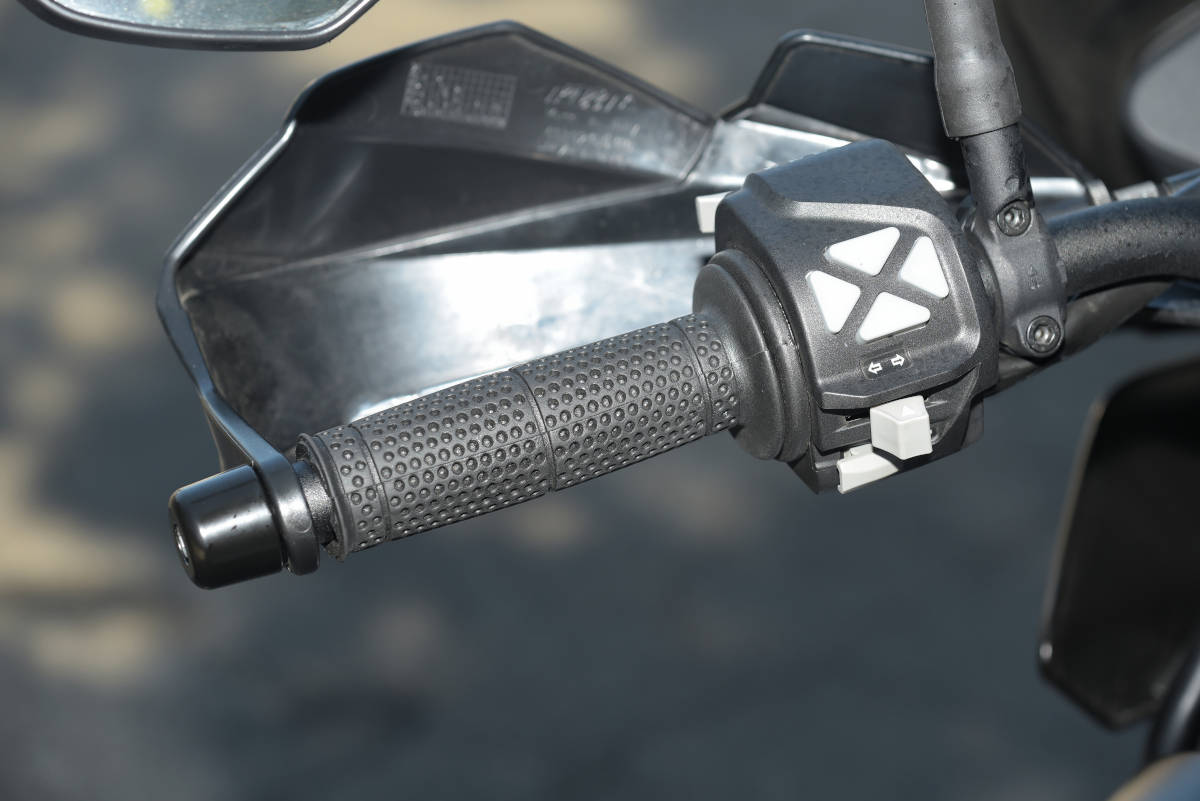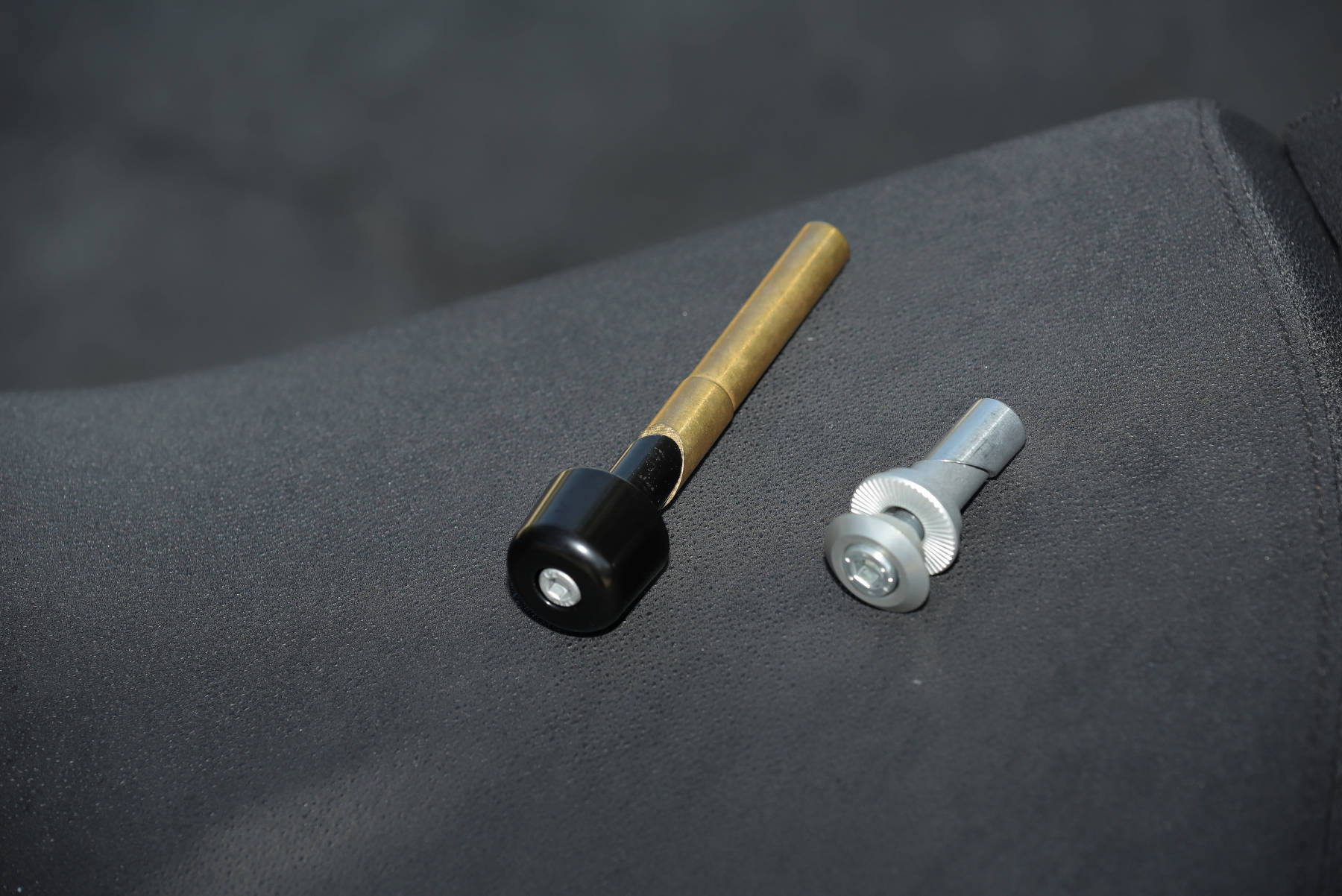
This is the latest installment in a series of articles regarding our modification of a 2019 KTM 790 Adventure. You can work your way back through links to prior articles by looking at Part 3.
Since our modifications are focused on increasing the street performance of the bike, our main modification has been to swap cast aluminum 19/17″ wheels for the spoked 21/18″ stockers. Handlebar vibration is not a significant issue on the 790 Adventure, particularly when used off-road. It can become an issue, however, while droning along the highway for extended periods.
We took two simple steps to address this. First, we swapped out the relatively hard stock grips for Progrip Rally Grips (model 714-102). These grips are much more comfortable than the stock grips, and they retail for less than $15.00. They are wider in diameter, and absorb vibration well without feeling too squishy. Consumer reviews online for the 714-102 grips are outstanding, and we agree with the general consensus.

Installing the Rally Grips was a bit tricky. The stock left grip rides on a removable tube, and the Rally Grip on that side installs directly on the handlebar, rather than the tube. On the throttle side, we had to re-use the throttle tube and carefully remove the stock grip from it.
With a box cutter, we cut the stock right grip beginning at the left side (fat side adjacent to the brake reservoir) and carefully stripped off the old grip (and any parts left glued to the throttle tube). After heating the Rally Grip with a hair dryer, we were able to slide it onto the throttle tube without too much trouble. We used a small amount of glue on the left side, but none on the throttle side, where ridges on the throttle tube keep the new grip from rotating. Of course, we had to remove the closed ends of each grip, which is easily done with a razor blade.
While the new grips certainly helped, we got a BIG reduction in handlebar vibration by installing KTM OEM bar-end weights. These bar-end weights are stock items on other KTM parallel-twins, including the street-focused 790 Duke and 890 Duke R. The KTM part number for the weights is 61002004000, and they retail for just over $60.00 for a pair. You will also need two screws that cost just a couple bucks (KTM part number 0912060653).
The new bar-end weights are 7.5 ounces each, as opposed to 1.3 ounces for each of the stock items that are easily removed and replaced. That means you add less than 1 pound of weight to your bike in exchange for a significant increase in comfort – I wouldn’t ride without them, now.
Stay tuned for a final report on our 790 Adventure Project bike.






While Dirck’s efforts to quell unwanted handlebar vibration are valid, I wonder why the oft-criticised method of rubber-mounting bars is not more common? I have three such bikes; two singles and a Ducati-powered Cagiva Gran Canyon, and can see absolutely no downside to it, and it really does work to reduce vibration. After all, steering is more down to weight transfer and geometry, and we are told not to have a vice-like grip on the bars. Possibly, front-end feel is diminished, but on a bike where the last ounce of precision and handling performance is not the major priority, its the best way to go for hand and arm comfort.
Converting a bike to safe resilient bar mounts ought to be possible, and I bought such a rig for one I had but never got around to machining the top yoke to fit it.
Nick
Nick, you make some good points. I’m actually pretty happy already (this isn’t a horribly buzzy bike to begin with), and I don’t want to sacrifice any more feel from the front end.
Those ProGrip Rally grips (along with Symtec ‘Heat Demons’ grip heaters) are almost always the first thing add to a newly acquired motorcycle. Tough to beat the value in those grips.
For me too, the 714 grips are the first addition to each and every bike I get my hands on; must be close to twenty now, so I wish I could have got a bulk deal on them! I’ve never considered them specifically as anti-vibration, but because they provide much better traction on the bars with less hand grip, I guess the transmission of vibration is reduced. Throttle control is enhanced for the same reason, and cramp is reduced.
An economic method of adding significant bar-end weight is to buy those made in India for Enfields. Preferably fix them using the wedge-clamps as shown in Dirck’s picture for security. Easy to do if you have a lathe!
Nick
Ditto. Probably the best grips out there. Put them on every bike I own.
Same here, only grip I’ve been using since late 90s, on every single bike, from street to dirt. Woman at Cycle Gear told me a few years ago they are the only grip people actually come in and specifically ask for. And it’s usually the one she recommended first. Lyndon Poskitt uses them on his bikes too, in one Races 2 Places video he is replacing them finally after several years of round the world travel and rally racing.
what modifications did you have to make to the SW mortech EVO engage tank bag to mount it on the KTM 790
I’ll supplement this article with this info later this week
An old trick for removing grips… compressed air. Insert the tip of the air nozzle under the edge of the grip, holding the grip with your other hand to trap the air pressure between the grip and the bar or throttle tube. The grip will expand slightly and allow you to slide/work the grip off the bar/tube with relatively little effort. Reverse the procedure if installing the new grips dry… I wouldn’t recommend air if gluing the new grips on, potentially VERY messy. I have heard reasonable arguments on both sides, to glue or not to glue. I don’t glue (or hairspray, another old trick) and use lockwire like the track stars do.
“The stock left grip rides on a removable tube”
Huh? Why is that? Seems like a strange design choice. Perhaps its to reduce assembly cost? But they could use lock-on grips like they use on their motocross models.
Normally the ID of the right grip is larger than the left because it has to slip over the throttle tube.
I can imagine, if I really thry hard enough, that having the same ID left and right is easier in terms of cost, etc.
These two potential solutions damp mechanical vibration in audio components: clear silicone sealant and a 3M product called ISODAMP used to damp MRI magnets. ISODAMP sheets come in various different thicknesses, each with a different “duro” #.
I suspect silicone sealant would work well. Of course sealant might interfere with electrical harness cables running through the center of the bars; harness wire may be difficult to remove later.
For a weekend I rented an early vintage BMW F800GS. IMO, flat out, the 800 would out accelerate my 2000 BMW R1150GS. But the 800s buzzing wore me out. By comparison the 1150 vibes never intruded. And of course in a roll on contest invert the results.
And just where would the silicone sealant GO?
Fill the interior of the handlebar. Absorbs the vibes. Theoretically.
I wanted to rid one motorcycle of high frequency vibration so I filled a 3/8” rubber hose with lead pellets and fished it through the inside of the handlebar with help from some silicone lubricant. I was happy I managed to complete the task but the vibration was only reduced perhaps 20%, disappointing result. Rox risers seems to have some positive results based on blog reports.
My very off-the-cuff take, I expect this is because bar-end weights change the resonant frequency of the system whereas this just dampened things a bit. No idea about the box riser part.